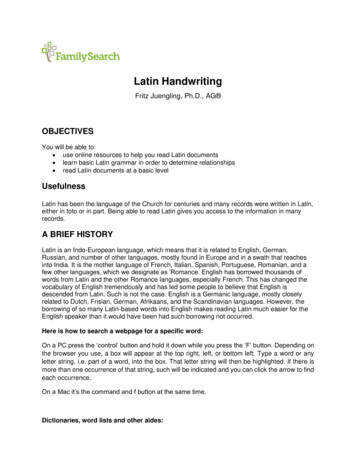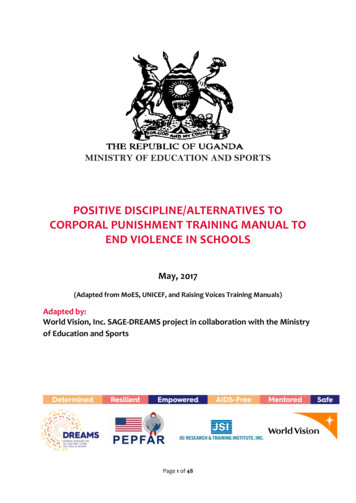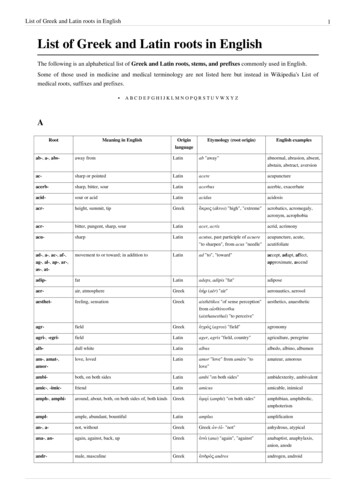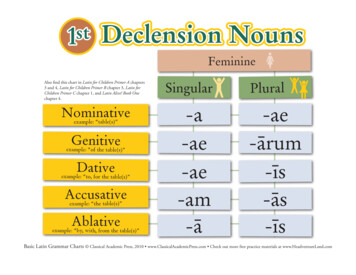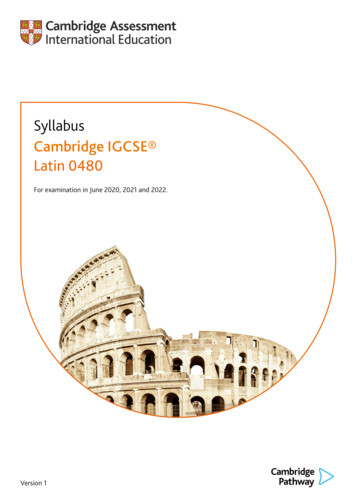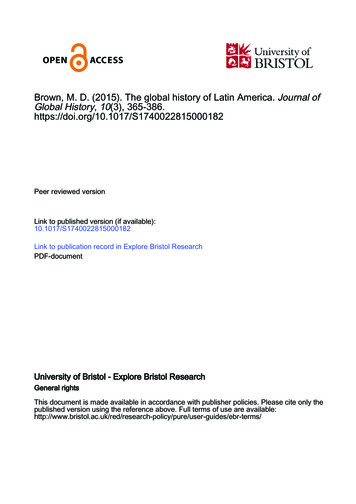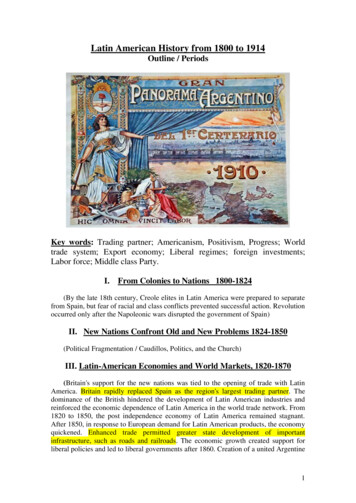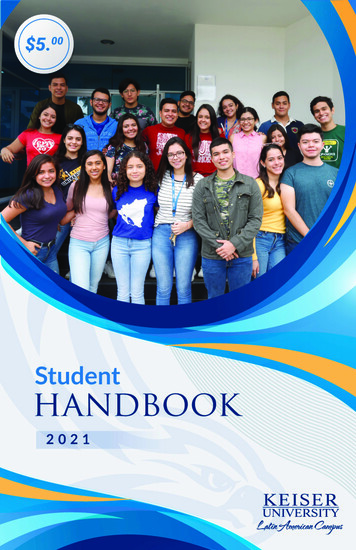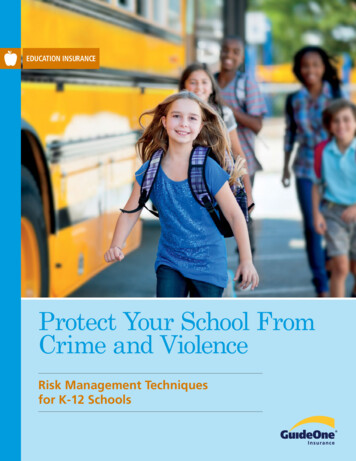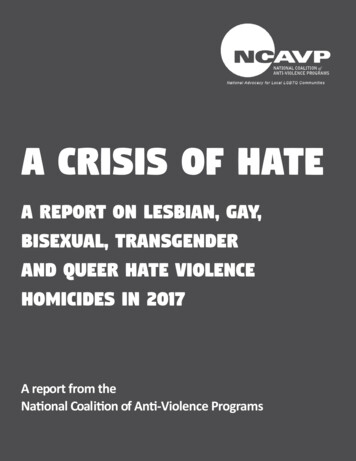
Transcription
School-Related Violence in LatinAmerica and the Caribbean:Building an Evidence Base forStronger SchoolsCirenia Chávez, Victor Cebotari, María José Benítez, DominicRichardson, Chii Fen Hiu and Juliana ZapataOffice of Research - Innocenti Working PaperWP-2021-02 January 2020
School-Related Violence in Latin America and the Caribbean:Building an Evidence Base for Stronger SchoolsInnocenti Working Paper 2021-02UNICEF OFFICE OF RESEARCH – INNOCENTIThe Office of Research – Innocenti is UNICEF’s dedicated research centre. It undertakes research onemerging or current issues to inform the strategic directions, policies and programmes of UNICEFand its partners, shape global debates on child rights and development, and inform the globalresearch and policy agenda for all children, particularly the most vulnerable.Publications produced by the Office are contributions to a global debate on children and may notnecessarily reflect UNICEF policies or approaches. The views expressed are those of the authors.The Office of Research – Innocenti receives financial support from the Government of Italy, whilefunding for specific projects is also provided by other governments, international institutions andprivate sources, including UNICEF National Committees.For further information and to download or order this and other publications, please visit the websiteat www.unicef-irc.org.INNOCENTI WORKING PAPERSUNICEF Office of Research Working Papers are intended to disseminate initial research contributionswithin the programme of work, addressing social, economic and institutional aspects of the realizationof the human rights of children.The findings, interpretations and conclusions expressed in this paper are those of the author and donot necessarily reflect the policies or views of UNICEF.This paper has been peer reviewed both externally and within UNICEF.The text has not been edited to official publications standards and UNICEF accepts no responsibility forerrors.Extracts from this publication may be freely reproduced with due acknowledgement. Requests to utilizelarger portions or the full publication should be addressed to the Communications Unit at: florence@unicef.org.For readers wishing to cite this document, we suggest the following form:Chávez, C., Cebotari, V., Benítez, M.J., Richardson, D., Fen Hiu, C., and Zapata, J. (2021), School-RelatedViolence in Latin America and the Caribbean: Building an Evidence Base for Stronger Schools. InnocentiWorking Paper 2021-02. Florence: UNICEF Office of Research – Innocenti. 2021 United Nations Children’s Fund (UNICEF)Correspondence should be addressed to:UNICEF Office of Research – InnocentiVia degli Alfani 5850121 Florence, ItalyTel.: ( 39) 055 20330Fax: ( 39) 055 2033 ocentifacebook.com/UnicefInnocenti2
School-Related Violence in Latin America and the Caribbean:Building an Evidence Base for Stronger SchoolsInnocenti Working Paper 2021-02SCHOOL-RELATED VIOLENCE IN LATIN AMERICA AND THE CARIBBEAN:BUILDING AN EVIDENCE BASE FOR STRONGER SCHOOLSCirenia Chávez, Victor Cebotari, María José Benítez, Dominic Richardson, Chii Fen Hiu and Juliana Zapata3
School-Related Violence in Latin America and the Caribbean:Building an Evidence Base for Stronger SchoolsInnocenti Working Paper 2021-02ACRONYMSAISAsociación Institución Salesiana (Salesian Institution Association)CRCConvention on the Rights of the ChildECLACEconomic Commission for Latin America and the CaribbeanFEDISALFundación para la Educación Integral Salvadoreña (Salvadoran Foundation ofIntegrated Education)FUSALMOFundación Salvador del Mundo (Foundation Savior of the World)GBVGender-based violenceGIZDeutsche Gesellschaft für Internationale Zusammenarbeit (German Agency forInternational Cooperation)GSHSGlobal School-based Student Health SurveysHBSCHealth Behavior in School-aged Children StudyLACLatin America and the CaribbeanLLECELatin American Laboratory for Assessment of the Quality of EducationTERCETercer Estudio Regional Comparativo y Explicativo (Third Regional Comparativeand Explanatory Study)PERCEPrimer Estudio Regional Comparativo y Explicativo (First Regional Comparativeand Explanatory Study)POWAProductive Organization for Women in ActionPRONACEPrograma Nacional de Convivencia Escolar (National Program of SchoolCoexistence)SERCESegundo Estudio Regional Comparativo y Explicativo (Second RegionalComparative and Explanatory Study)SWPBISSchool-Wide Positive Behavior Intervention and Support SystemUSAIDUnited States Agency for International Development*Names in parenthesis are informal translations.4
School-Related Violence in Latin America and the Caribbean:Building an Evidence Base for Stronger SchoolsInnocenti Working Paper 2021-02CONTENTSEXECUTIVE SUMMARY . . . . . . . . . . . . . . . . . . . . . . . . . . . . . . . . . . . . . . . . . . . . . . . . . . . . . . . . . . . . . . . . . . 71.INTRODUCTION. . . . . . . . . . . . . . . . . . . . . . . . . . . . . . . . . . . . . . . . . . . . . . . . . . . . . . . . . . . . . . . . . . . . . 101.1 A brief background of violence in the LAC region . . . . . . . . . . . . . . . . . . . . . . . . . . . . . . . . . . . . . . 101.2 Aims and objectives of the research . . . . . . . . . . . . . . . . . . . . . . . . . . . . . . . . . . . . . . . . . . . . . . . . . 111.3 Methods and data . . . . . . . . . . . . . . . . . . . . . . . . . . . . . . . . . . . . . . . . . . . . . . . . . . . . . . . . . . . . . . . . 122. KEY FINDINGS. . . . . . . . . . . . . . . . . . . . . . . . . . . . . . . . . . . . . . . . . . . . . . . . . . . . . . . . . . . . . . . . . . . . . . 142.1 A brief overview of the literature: State of the evidence on school-related violence. . . . . . . . . . . 142.2 Prevalence of school-related violence in select LAC countries. . . . . . . . . . . . . . . . . . . . . . . . . . . . . 162.3 Association between school-related violence and learning in LAC countries . . . . . . . . . . . . . . . . 212.4 Analysis of existing interventions . . . . . . . . . . . . . . . . . . . . . . . . . . . . . . . . . . . . . . . . . . . . . . . . . . . 242.5 Discussion of findings and limitations. . . . . . . . . . . . . . . . . . . . . . . . . . . . . . . . . . . . . . . . . . . . . . . . 333. RECOMMENDATIONS FOR PROGRAMME, POLICY AND RESEARCH. . . . . . . . . . . . . . . . . . . . . . . . . . 36REFERENCES . . . . . . . . . . . . . . . . . . . . . . . . . . . . . . . . . . . . . . . . . . . . . . . . . . . . . . . . . . . . . . . . . . . . . . . . . . 39ANNEX. . . . . . . . . . . . . . . . . . . . . . . . . . . . . . . . . . . . . . . . . . . . . . . . . . . . . . . . . . . . . . . . . . . . . . . . . . . . . . . . 42A. Methodology for models. . . . . . . . . . . . . . . . . . . . . . . . . . . . . . . . . . . . . . . . . . . . . . . . . . . . . . . . . . . . 46B. Glossary of categories for types of violence affecting children. . . . . . . . . . . . . . . . . . . . . . . . . . . . . 48C. Classification of initiatives by type of intervention and by type of violence . . . . . . . . . . . . . . . . . . 50TABLESTable 1. Bullying victimization prevalence by typeTable 2. Characteristics of evaluated initiatives and their validityFIGURESFigure 1. Percentage (%) of parents who believe the likelihood of fighting with weapons andassaults that lead to serious injury are likely or highly likelyFigure 2. Percentage (%) of students who were victims of bullying5
School-Related Violence in Latin America and the Caribbean:Building an Evidence Base for Stronger SchoolsInnocenti Working Paper 2021-02Figure 3. Difference (%) in prevalence of bullying between girls and boys, selected countriesFigure 4. Gender differences in bullying victimization, average for TERCE countriesFigure 5. School type differences in being bullying victimizationFigure 6. Differences in bullying victimization between private and public schools, average forTERCE countriesFigure 7. Comparison of reading scores, students threatened and non-threatenedFigure 8. Comparison of reading scores, afraid and not afraid studentsFigure 9. Number of reported initiatives by countryFigure 10. Number of initiatives by type6
School-Related Violence in Latin America and the Caribbean:Building an Evidence Base for Stronger SchoolsInnocenti Working Paper 2021-02EXECUTIVE SUMMARYWhat is the evidence on school-related violence?The prevalence of school-related violence and in particular, bullying – defined as intentional andaggressive behavior occurring repeatedly against a victim where there is a real or perceived powerimbalance – is not a new or isolated phenomenon, nor is it limited to certain schools or countries.Abundant evidence indicates that bullying is widespread and has a negative impact on educationaloutcomes. Children who are victims of bullying can also be affected emotionally and physically inboth the short and long terms. Evidence from low- and middle-income countries on bullying is lessextensive when compared to the evidence available on predictors and effects of bullying from highincome countries. However, some findings for the Latin American and Caribbean (LAC) region seemto suggest a similar picture, with a high prevalence of bullying victimization and association to lowerreading scores in different subjects tested.What is the prevalence of school-related violence in LAC and its association tolearning outcomes?This working paper first uses data from UNESCO’s Third Regional Comparative and Explanatory Study(Tercer Estudio Regional Comparativo y Explicativo, TERCE) for nationally representative samples ofsixth grade students to determine the prevalence of bullying and its association to learning outcomesin 15 countries of the LAC region. It then looks at interventions in countries of the region to mitigatethe impacts of violence based on information requested from UNICEF Country Offices. The study foundthat: On average, two in five sixth grade students were victims of some form of bullying in school.When disaggregating by type of bullying, evidence showed that one in eight children reportedbeing hit, 1 in 10 pupils reported being afraid of their classmates, and 1 in 12 children reportedbeing threatened in schools by their classmates. Sixth grade boys were bullied slightly more than girls, although not in all countries. Whenconsidering the different forms for bullying, the average rates of victimization for all itemswere higher for boys in comparison to girls, except for being left out. Bullying rates varied by types of school. Children in public schools reported, on average,higher rates of bullying than children in private schools. Bullying rates were not found tosignificantly differ between urban and rural schools. The associations between bullying and reading scores were weakest for physical bullyingand strongest for psychological bullying. In particular, a child’s self-report of fear in schoolwas the most robust and consistent bullying indicator associated to lower reading scores incomparison to other items explored in this analysis.How are LAC countries responding to mitigate the impacts of different forms ofviolence in and around schools? This paper identified 93 interventions in schools and communities to address the impacts ofviolence in and around schools in 12 LAC countries. El Salvador had the highest number ofidentified initiatives, followed by Honduras and Mexico.7
School-Related Violence in Latin America and the Caribbean:Building an Evidence Base for Stronger SchoolsInnocenti Working Paper 2021-02 A large share of the violence in the region was identified as stemming from gang violenceor armed conflict or other types of community violence. Of the 93 initiatives implemented totackle this problem, 32 were identified as addressing this form of violence. Evaluation of the programs included is lacking or of poor quality. Only 17 of the 93 initiativesidentified in this analysis have been evaluated; only one initiative had a baseline and fourhad a control group. Seven out of 17 evaluations were observational and relied on qualitativeparticipatory approaches, seven used mixed methods and two relied on quantitativeexperimental and quasi-experimental approaches.What are the potential recommendations for policy making and research?Policy and programme recommendations: Target interventions to mitigate the impacts of bullying among those countries and groupsmost affected. The evidence shows that bullying in some countries of the region is high andthat there are important differences in bullying victimization when disaggregating data bygender and when comparing public and private institutions. Programme designers and policymakers should make special efforts to ensure interventions target boys and particularly, thatthey reach public schools. Use evidence-based strategies to identify and target potential beneficiaries of futureprogrammes and interventions. For example, the identification of municipalities (third leveladministrative units in most LAC countries) with schools having the highest incidence orprevalence of bullying victimization is a good starting point to direct programmes that aim tocurb or mitigate their impacts. Create an environment for children to learn safely. The evidence shows that bullying, andpsychological bullying in particular, can affect children’s learning. While it is important totarget overt acts of physical bullying, psychological bullying warrants special attention as itcan be the most damaging for learning experiences and has the greatest potential to affectscores. Creating safe environments requires knowledge of the effects of violence and aconcerted effort and shared commitment from different actors including school personnel,community members, parents and students themselves. Support and promote the monitoring and evaluation of initiatives to identify what works andwhy, in addition to providing opportunities for cross-national learning. Use baselines and control groups in evaluation and monitoring to strengthen the quality ofevaluations and improve the understanding of the successes (and barriers) of the programme,the ways objectives are met by the project, and areas to improve in the short and long term. Provide information on cost effectiveness in programme evaluations to gain a betterunderstanding of what the most cost efficient programmes are; then consider their potentialfor replication and scale-up with appropriate contextual modifications. Clearly outline at the outset of project design which type(s) of violence the programme willaddress and develop clear and measurable indicators to monitor progress and programmeeffectiveness.8
School-Related Violence in Latin America and the Caribbean:Building an Evidence Base for Stronger SchoolsInnocenti Working Paper 2021-02 Design and support the implementation of initiatives with a multisectoral approach – i.e.,those that involve coordination between education, child protection, and health and publicsafety ministries/agencies at national, regional and local levels – to also address the drivers ofviolence. Support and build the mechanisms with which to empower local stakeholders. Include theactive participation of community, families and young people in the design, development andimplementation of the program.Research recommendations Expand data collection to other countries that have not been covered in the TERCE survey sofar, including those in Central America as well as Caribbean countries - most of which are notrepresented in TERCE data. Explore the prevalence and impacts of other types of violence, such as online violence andschool-related gender-based violence, on both boys and girls. Include additional indicators in future rounds of surveys. While data from TERCE focuses onbullying by peers, there are other forms of school-related violence that are not addressed inthe data and warrant attention, including corporal punishment by teachers as well as sexualviolence perpetrated by peers and/or teachers. Existing studies in the region have overlookedthe role of teachers – both as protectors or as perpetrators from/of violence. Continue monitoring the prevalence of school-related violence and bullying in the countries ofthe region by collecting data exclusively on this phenomenon. Include comparable measurements that are reported by children and adults – includingparents and teachers, because they may perceive violence and learning differently. Use datasets with additional indicators on violence and perpetration to explore the impactof violence on outcomes beyond reading scores. Specifically, explore how violence in thecommunity and around schools impacts truancy and dropping out, as well as other riskybehaviors including substance use and abuse. Collect longitudinal data within the countries and across the region to better understand theadverse effects of violence throughout the life course. Consider the use of qualitative methods research to explore violence in and around schools.Particularly, it can help understand and identify harmful social norms that may predisposecertain groups in the region to bullying victimization – including sex, academic performance,and physical disability among others. Consider expanding the use of mixed methods, quasi and experimental approaches for theevaluation of programmes. The limited programmes that had evaluations were largely of aqualitative nature.9
School-Related Violence in Latin America and the Caribbean:Building an Evidence Base for Stronger SchoolsInnocenti Working Paper 2021-021. INTRODUCTION1.1 A brief background of violence in the LAC regionIn recent decades violence in and around schools has become a serious concern in Latin America andthe Caribbean (LAC). As a starting point, LAC accounts for 8 per cent of the world’s population andyet, 37 per cent of global homicides occur in the region (Chioda, 2017). In 2015, the average regionalhomicide rate in LAC was the highest globally,1 and 9 out of the 10 countries with the highest homiciderates in the world were concentrated in the region,2 with El Salvador, Honduras, and Venezueladisplaying the highest homicides rates globally3 (World Bank, 2019).Roughly half of homicide victims in Latin America are young, between the ages of 15 and 29 (Muggahand Aguirre, 2018), with males overrepresented among victims,4 while girls are vulnerable to otherforms of violence, including physical, sexual and emotional intimate partner violence and non-partnersexual violence.5 While men are more likely to experience higher levels of lethal violence in comparisonto women, it is important to highlight that 38 per cent of all women murdered in the Americas are killedby a partner and that nearly one third of women who have had partners have been physically and/or sexually abused by an intimate partner at some point in life (PAHO and WHO, 2017). The dangerousenvironments in some countries of the LAC region are a consequence of a myriad of factors. Theseinclude, but are not limited to, the presence of armed groups; the pervasive drug trafficking and smallarms trade that have made weaponry easily accessible; the profitability of organized criminal activity,and in particular the drug trade; youth unemployment; rigid gender norms; high levels of inequalitycoupled with unfulfilled aspirations of young citizens; rapid and disorganized urbanization processes;increases in the number of single parent female households; and weak institutions (Chioda, 2017;Imbusch, Misse and Carrión, 2011; Muggah and Aguirre, 2018).The endemic violence reported across some LAC countries has placed a heavy toll on children, affectingnot only their health and overall well-being but also their learning processes. Violence has permeatedmultiple environments including communities, homes and schools. In this last setting particularly,evidence shows that 51 per cent of sixth grade students in 16 countries of Latin America experiencevarious forms of violence in school, most commonly in the form of theft (39 per cent), verbal bullying(27 per cent), and physical violence (17 per cent) (Román and Murillo, 2011). Experiencing violencejeopardizes the educational rights of millions of children and adolescents in the region and significantlyaffects their educational performance – threatening not only their safety today, but their opportunitiesfor a better future.The protection of children in educational settings is a priority for UNICEF. As the basis for UNICEF’swork, the United Nations Convention on the Rights of the Child (CRC) commits all relevant parties toensuring a child’s right to education (art. 28) and protection from all forms of violence while in the careof parent(s), legal guardian(s) or any other person who has the care of the child (art. 19.1) (UN General1Regional homicide stood at 22.3 homicides per population of 100,000 in 2015, which was twice the rate for Sub-Saharan Africa (9.4), and more than fivetimes the rate for the Middle East and North Africa (3.4) (World Bank, 2019).2This picture is more complex however, and it is important to clarify that within the region there are significant variations in the levels of violence: whileChile has a homicide rate comparable to Sweden, some of the countries of the northern triangle of Central America have the highest homicide ratesglobally.3The homicide rate was 82.8, 56.5, and 56.3 homicides per 100,000 population in 2016 for El Salvador, Honduras, and Venezuela, respectively.4Boys in the LAC region under 20 years of age are seven times more likely than girls to die as a result of interpersonal violence (UNICEF, 2014).5According to Muggah and Aguirre (2018), victimization surveys indicate that violence against women and children is pervasive: 65 per cent of respondentsin Latin America claim that the most harmful types of violence are against women and 63 per cent claim it is against children.10
School-Related Violence in Latin America and the Caribbean:Building an Evidence Base for Stronger SchoolsInnocenti Working Paper 2021-02Assembly, 1989). Under this mandate, UNICEF along with other partner agencies has implementedvarious initiatives to address the issue of violence in and around schools, including the launch of the#EndViolence campaign in 2013 6 which emphasizes the urgency of addressing this issue and whichresulted in the #ENDviolence Youth Manifesto,7 presented to ministers at the Education World Forum inJanuary 2019.UNICEF is also a key partner in global initiatives such as the UN Office of the Special Representativeof the Secretary-General (SRSG/VAC) on Violence Against Children,8 which began in 2009 as a globalindependent advocate championing for the prevention and elimination of all forms of violenceagainst children. In 2016, another UNICEF initiative, the Global Partnership to End Violence AgainstChildren,9 announced it would raise awareness, mobilize funds and equip practitioners with the toolsto create safe and secure societies to end all violence against children everywhere. At the regionallevel, the UNICEF Latin American and Caribbean Regional Office and the Global Business Coalitionfor Education support the region through the ‘Strong Schools Initiative’ (UNICEF, 2015) which aims toidentify and strengthen policies and programmes that effectively create safe schools and protectivelearning environments. These initiatives and others aim to ensure the achievement of the SustainableDevelopment Goals (SDGs) and child-focused targets such as those under SDG 4. Quality Educationand SDG 16. Peace and Justice (specifically, target 16.2, to end abuse, exploitation, trafficking and allforms of violence against and torture of children).1.2 Aims and objectives of the researchThis working paper has two main objectives. Drawing from existing data from UNESCO’s ThirdRegional Comparative and Explanatory Study (TERCE), the paper first examines the prevalence ofbullying and its association to learning outcomes in 15 countries of the LAC region.10 Using dataobtained from UNICEF select country offices in the region, the second part of the paper exploresexisting initiatives in the region that address the impacts of bullying and other forms of violence in andaround schools. The overarching questions guiding this research are:1. What is the prevalence of bullying and school-related violence in select countries of the LatinAmerican and Caribbean region?2. Is bullying victimization associated to lower performance on standardized test scores?3. What are the promising interventions that have decreased the impacts of violence in schools incountries of the region? What are some of their limitations?To respond to these questions, the paper is structured into three sections: Section 1 is an introductionto the study, as well as the methods and data sources used. Section 2 details the key research findings,focusing first on the state of the evidence of the existing literature on this topic, followed by ananalysis of the prevalence of school-related violence and its association to learning outcomes. The last6Further information on the #EndViolence campaign can be found at the following link: uth-manifesto8Further information on the UNSRSG on Violence against Children can be found at the following link: violenceagainstchildren.un.org/.9Further information on the Global Partnership to End Violence against Children can be found at the following link: end-violence.org/.10 While the data informing this paper focuses on bullying by peers, there are other forms of school-related violence that are not addressed in the availabledata and warrant attention, including corporal punishment by teachers as well as sexual violence perpetrated by peers and/or teachers.11
School-Related Violence in Latin America and the Caribbean:Building an Evidence Base for Stronger SchoolsInnocenti Working Paper 2021-02subsection contains an analysis of existing interventions, their limitations, and the forms of violenceaddressed. Section 3 focuses on promising interventions and lays out potential recommendations formoving forward with research and programming to build safer schools in the region.1.3 Methods and dataTo measure the prevalence of school-related violence and its association to learning outcomes, datafrom UNESCO’s TERCE,11 produced by the Latin American Laboratory for the Assessment of the Qualityof Education (LLECE) was used. TERCE is the only survey which assesses the performance of thirdand sixth grade students in reading, writing, and mathematics and has relevant indicators on bullyingfor 15 Latin American and Caribbean countries.12 13 The analysis carried out only included data fromsixth grade students from private and public institutions as third grade students were not asked aboutbullying and violence in and around schools. The samples for the sixth grade included students agedapproximately 12 and 13 years in 3,600 classrooms in 15 Latin American countries (UNESCO, 2018).Sub-national data was included for the Mexican state of Nuevo León as data was also collected andavailable. Both parents and students were asked about their experiences of violence in and aroundschools. More specifically:Students’ parents first reported on five items on perceived violence in the community in which theschool was located: 1) fights with weapons, 2) theft and drugs sales, 3) fights with neighbors, 4)assaults that lead to serious injury, and 5) vandalism. Parents were asked how likely they thought theabove events would occur in the community within which the school was located; they answered on afour-point Likert scale which included ‘highly unlikely’, ‘unlikely’, ‘likely’, and ‘highly likely’. Students, onthe other hand, self-reported on six bullying items: 1) feeling afraid of a classmate, 2) being threatened,3) being hit, 4) being teased, 5) being left out, and 6) being forced to do things that (the student) didnot want to do. Students were asked a simple ‘yes’ or ‘no’ question regarding whether or not theaforementioned experiences affected them when they were in school. An extra ‘any bullying’ item wascalculated to obtain the prevalence of students experiencing at least one form of the bullying typeslisted above (see Annex).Descriptive statistics are first used to show parental perceived likelihood of violence in the schoolcommunity as well as the prevalence rates for bullying items for each country (see Annex for samplesizes). Linear mixed models were then used to measure the association between parents’ perceivedrisk of violence and students’ bullying victimization experiences with reading scores (see Annex A forfurther detail).The second part of the research, which looks at existing interventions to mitigate the impacts ofviolence in and around schools, uses a purposive sampling technique based on three criteria: 1)representation of interventions from each sub-region including South and Central America, Mexicoand the Caribbean, 2) countries reporting a variety of situations of violence in schools, and 3) countrieshaving achieved significant advances in the implementation of educational programs. Twelve countries11 The TERCE survey has been collected in three waves. The survey changes name with each wave (PERCE first wave in 1997; SERCE second wave in 2006;TERCE in 2014; the fourth wave is forthcoming and includes 20 Latin American countries and the state of Nuevo Leon in Mexico.12 Uruguay, Paraguay, Ecuador, Honduras, Nicaragua, Peru, Mexico, Costa Rica, Chile, Guatemala, Brazil, Panama, Argentina, Dominican Republic, andColombia.13 For more information on TERCE and the methodology, the link to the technical report is /pdf/Reporte-tecnico-TERCE.pdf.12
School-Related Violence in Latin America and the Caribbean:Building an Evidence Base for Stronger SchoolsInnocenti Working Paper 2021-02of the region14 were selected for this exercise. Infor
Violence in Latin America and the Caribbean: Building an Evidence Base for Stronger Schools. Innocenti Working Paper 2021-02. Florence: UNICEF Office of Research - Innocenti. . violence in and around schools in 12 LAC countries. El Salvador had the highest number of identified initiatives, followed by Honduras and Mexico. .

